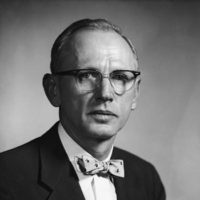
V. Everett Kinsey
Kresge Eye Institute

Arnall Patz
Johns Hopkins University
For discovering that excessive oxygen administration is the cause of retinopathy of prematurity in premature babies.
With the help of 75 ophthalmologists and pediatricians in 18 hospitals, this study confirmed conclusively earlier observations that the incidence of blindness among premature babies increased with the duration of exposure to oxygen.
Previous research had eliminated other possible etiologic agents, such as virus infection, lack of hormones in the infant, exposure of the premature infant’s eyes to light, lack of vitamin A in the mother, the administration of various vitamins and iron, blood transfusions and cow’s milk. Dr. Kinsey, a biochemist, had participated in many of the studies on these possible agents.
Based on a review of previously occurring cases, Dr. Patz observed alternate small premature babies kept at the routine high oxygen levels and at levels below 40 percent oxygen. Seven of 28 babies kept at the high levels were affected. There were none among 31 maintained at levels under 40 percent.
This critical observation prompted experiments with animals, which were finally successful. Newborn animals kept at high oxygen levels developed a condition like that in babies, while littermates not so exposed did not.
Within a period of six months, data were accumulated through the cooperative study that would have taken a single hospital several years. Among babies weighing less than 1500 grams at birth, 25 percent of the infants receiving routine oxygen developed cicatricial retrolental fibroplasia, while only 6 percent of the infants on curtailed oxygen had the condition. The study showed that limiting the oxygen was without effect on survival.
In the United States alone, putting into effect the results of this coordinated research should prevent blindness in several hundred premature infants each year.
These studies were part of the evidence on which a coordinated investigation involving 18 hospitals and 75 ophthalmologists and pediatricians was based, and which has now produced conclusive and definitive proof of the relation between high oxygen concentration and this blinding condition in premature babies.
In this instance, the persistence of an individual ophthalmologist against considerable obstacles is notable. He was openly discouraged by an outstanding consultant in the pathology of the eye who believed he was on a mistaken lead. Using at first his own resources, he sought clinical and laboratory facilities to try out his theory. As a physician in private practice, he found time to explore the subject. He has set a standard for other practitioners by his undiscourageable search.
